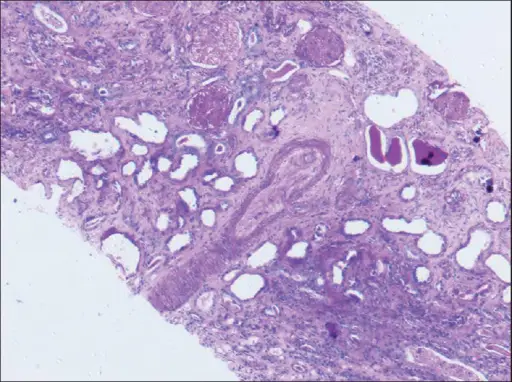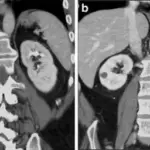Diffuse cortical necrosis is an infrequent patchy necrosis of the renal cortex condition occurring most often after an obstetric emergency.
What is the Pathology of Diffuse Cortical Necrosis?
The pathology of diffuse cortical necrosis is:
-Etiology: The cause of diffuse cortical necrosis is obstetric emergency
-Genes involved: Unknown.
-Pathogenesis: The sequence of events that lead to diffuse cortical necrosis follows obstetric emergencies resulting in cortical destruction, with features of necrosis. arteriolar and glomerular microthrombi contribute to the necrosis and renal damage.
-Morphology: The morphology associated with diffuse cortical necrosis shows cortex necrosis, glomeruli, hemorrhage.
-Histology: The histology associated with diffuse cortical necrosis shows fibrin lumps in the glomerular capillaries.
How does Diffuse Cortical Necrosis Present?
Patients with diffuse cortical necrosis are typically more common in females present at the age range of childbearing age. The symptoms, features, and clinical findings associated with diffuse cortical necrosis include oliguria, hematuria, costovertebral tenderness, flank pain, palpable, and tender kidneys.
How is Diffuse Cortical Necrosis Diagnosed?
Diffuse cortical necrosis is diagnosed by laboratory studies such as complete blood count (CBC), serum electrolytes, coagulation studies, and urinalysis. Imaging studies such as Radiography, ultrasonography and renal scanning, and kidney biopsy.
How is Diffuse Cortical Necrosis Treated?
Diffuse cortical necrosis is treated by medical care intensive care- IV crystalloids, colloids, blood products, and dialysis. Dietary measures such as low-potassium, low-phosphorus.
What is the Prognosis of Diffuse Cortical Necrosis?
The prognosis of diffuse cortical necrosis is poor when bilateral and symmetric, fair when patchy cortical necrosis which may permit survival.



